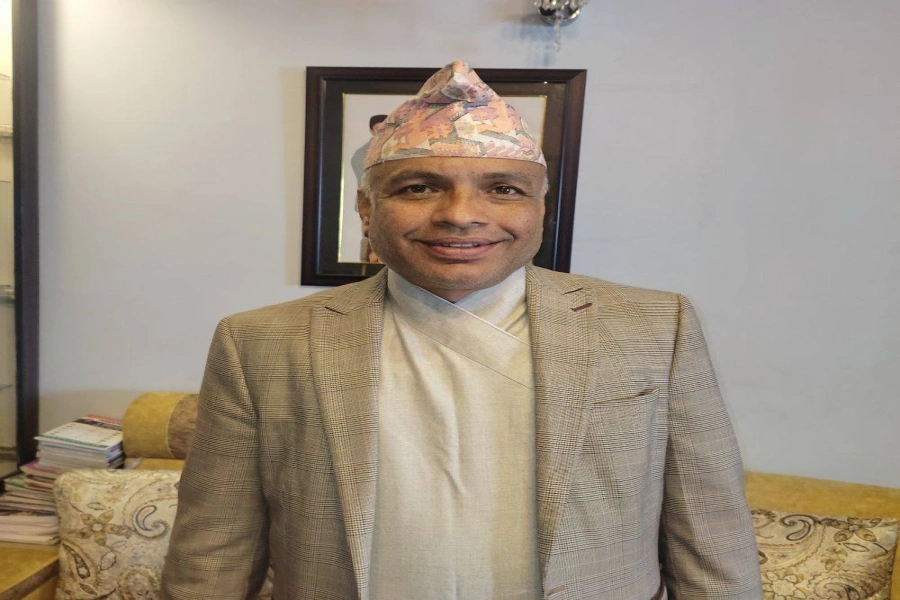Life appeared to move at a pace slowed down, perhaps by the afternoon sun. Mules, buses, motorcycles, cars all shared the highway with women, much like those in Nepal’s Tarai, who made balancing things on their heads look effortless as they walked dressed in brightly colored wardrobes. Roads were being paved, bananas being sold, barbers were busy giving haircuts, and children were playing in public squares.

File Photo: The earthquake has displaced tens of thousands of people who now live in IDP refugee camps in Haiti’s capital, Port-au-Prince, like the one pictured here.
What one wouldn’t be able to see through the windows of this military convoy’s jeep, however, was that less than a year after the quake, another deadly force was crumbling the Haitian population: cholera. For that, you would have had to follow international media outlets, most of which had linked that outbreak to the Nepali mission with whom this writer was traveling. In 2011, a report concluded that Nepalis had inadvertently brought the disease to the island. The international community largely accepted it. But a new scientific research published this year suggests that it may not be entirely true.
“Epidemiologic and microbiologic evidence strongly suggests that the United Nations peacekeeping troops from Nepal imported cholera to Haiti, contaminated the river tributary next to their base through a faulty sanitation system and caused a second disaster,” the New York Times wrote in their cover feature titled “In Haiti, Global Failures on a Cholera Epidemic” on March 31 this year.
The same article quoted G. Balakrish Nair, an Indian microbiologist, as saying “irrefutable molecular evidence” linked Haiti’s cholera to Nepal.
What was not known to public at the time, however, was that on March 26, a few days before the Times article was published, a new report on the Haiti cholera outbreak had been submitted for review to the Proceedings of the National Academy of Sciences of the United States of America (PNAS). Titled “Genomic diversity of 2010 Haitian cholera outbreak strains,” the study was conducted, and the report written, by a team of 20 experts, including Dr. Rita Colwell, the team leader.
New evidence
The authors who worked on the Genomic diversity of 2012 Haitian cholera outbreak strains report brought with them immense institutional resources and professional and academic expertise. Their affiliations ranged from University of Maryland’s Pathogen Research Institute, Institute for Genome Sciences and Department of Microbiology and Immunology, the Laboratory Sciences Division of International Centre for Diarrheal Disease Research in Bangladesh, and the Department of Microbiology at University of Dhaka, as well as the Department of Biology at Johns Hopkins University, amongst others.
Dr. Colwell, who led the team, is also a former Director of the National Science Foundation as well as former President of the University of Maryland Biotechnology Institute. Her team’s report was published on May 17 this year.
“The introduction (from Nepal) can’t be ruled out but it can’t be proven, either. I think the evidence is at best circumstantial, and it is not sufficient to account for the entire epidemic,” she told National Public Radio (NPR) a month after the publication.
For their research, the team collected samples from “victims in 18 towns across eight Arrondissements of Haiti. The results showed that two distinct populations of V. cholera coexisted in Haiti early in the epidemic, as written in the report.
In the report’s introduction, the team writes: “Although the molecular and genomic data in the previous reports cited here have been interpreted as being consistent with V. cholera being introduced to Haiti by outside visitors a definitive statement of source attribution cannot yet be made.”
Dr. David Sack is Professor of the International Health in the Global Disease Epidemiology and Control Department at the John Hopkins Bloomberg School of Public Health. In the same NPR news report, he said this about the cholera outbreak being attributed to Nepali troops:
“Cholera’s incubation period is at least 24 hours, sometimes two or three days. Just to have a cholera vibrio floating downstream, and considering the dilution factor – well, it raises questions in my mind. Not that it wasn’t imported. I think it was imported. I just question when it was imported.”
NPR notes that Nepali troops arrived in Haiti on October 8, and the first cholera case was recorded on October 12.
In the Genomic Diversity report, Dr. Colwell’s team reaches this conclusion: “Genomic analysis of V. cholera isolates obtained early in the Haitian cholera epidemic has provided evidence that two distinct Vibriopopulations, V.cholera 01 and V.choleraenon-01/0139, contributed to the cholera epidemic in Haiti.”
The 01 type is the one linked to Nepal whereas the non-01/0139 is the type the research team identified as the “sole pathogen isolated from 21% of the clinical specimens.” This led them to express the role of non-01/0139 in this epidemic “either alone or in concert with V.cholera 01, cannot be dismissed.”
Nepal’s response
Last year, just before world leaders gathered in New York for the annual United Nations General Assembly, one of the more definite reports concluding the cholera outbreak to Nepali troops was published.
This writer spoke to a high-ranking official at the Nepal Mission to the UN in New York about this issue, wondering if the Prime Minister, who was heading Nepal’s delegation and in a meeting in the next room at the time, would address the matter in any way. It isn’t worth dragging the issue any further, the official explained off the record. It was in Nepal’s interest to let the issue die down, he said, adding that the UN had recommended a few additional tests of the health of Nepal’s Peacekeeping troops, and Nepal had agreed to those conditions. This was, he explained, a good thing because now Nepali soldiers would go through more rigorous tests before being deployed overseas. Perhaps that was a diplomat’s “silver lining” approach.
When a cholera outbreak happened in Nepal in 2009, the Nepali government swiftly blamed it on rice distributed by the aid agency World Food Programme. The outbreak turned into a humanitarian and political crisis. How can leaders of a country who went through this remain silent when Nepali troops are blamed for an outbreak of an epidemic that has taken more than 7,500 lives and infected more than half a million people in Haiti? As a society, on grounds of humanity, how does it reflect on the world stage when we are so oblivious to another community undergoing the crisis we went through not so long ago? Despite everything, the Nepali peacekeeping troops had earned tremendous goodwill in Haiti. However, with the failure to express even shared grief with Haiti, the various Nepali leaderships in place between 2010 and now have done neither the Nepali troops nor Nepal any favors in front of the global community.

Almost two years after the outbreak, scientific curiosity and academic interest in public health and epidemics has inadvertently established that Nepalis may not have been at fault for thousands of deaths caused by an epidemic that remains a crisis in Haiti. Nepal took the blame quietly; Nepalis and Haitians suffered its consequences violently. Politicians in Haiti used it as an excuse to demand the end of the UN Mission there. Nepal’s leadership fell in two distinct camps on the matter; they either did not think about the issue at all, or made a political decision not to acknowledge it.
Shrestha is a writer and photographer. He traveled to Haiti in December 2010 to look into the cholera outbreak and the role of Nepali troops after the earthquake. His first report from Haiti was published in Republica that month. You can follow him on twitter @kashishds and email him at kashish@350nepal.org
U.N. chief sorry for U.N. role in deadly Haiti cholera outbreak
































